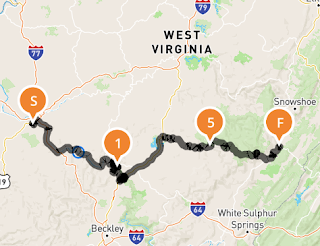Plug In West Michigan Podcast - Episode 8 - EVs in Winter
 Part of WKTV Journal Grand Rapids, MI Community Programming
Part of WKTV Journal Grand Rapids, MI Community ProgrammingListen Here: Plug-In West Michigan Podcast
Episode 8 - EVs in Winter
Show Notes
Show Notes
Introduction
- Host: Karl Bloss
- Blog: www.muskegonevguy.com
- Instagram @muskegonevguy
- West Michigan EV community: www.facebook.com/groups/WestMichiganEV/
- Guest: Ted Ooyevaar, EV owner, enthusiast and road warrior
- Theme song composed by Tyler Burke
- What happens to cars when it gets cold?
- All cars lose efficiency and range in the winter. Gas cars just burn more gas and need to warm up longer.
- Traction: I highly recommend winter tires no matter what car you have. The traction is so much better than so-called “all-season” tires, which I call “no season” tires.
- First let’s talk about the positives:
- If you’re just traveling around home, you just plug in at home in the comfort of your garage if you have one. No need to stand at a gas pump freezing.
- Remote car preheating - most EVs have apps that let you remote preheat the car or set a preheat timer.
- Preheating is much faster because you don’t need to warm engine block
- Preheating in the garage with the door closed
- You can run your home electrical devices from your EV during a power outage. See related blog post
- You’re not doing damage with cold starts like you do in a gas car. No crankcase pudding.
- Why does it happen?
- Cold battery is less efficient - it’s an electrochemical process
- Heater uses power
- Resistance from snow and slush
- Air density
- What does it mean?
- The car needs more power per mile driven.
- Charge longer or
- Charge more often
- It's not a big deal, just plan for it.
- Find public chargers: plugshare.com/ or get the PlugShare app.
- Use 110V outlets when you can with permission such as at hotels.
- What can you do about it?
- If you have a garage, park the car inside
- Preheat cabin
- Preheat batteries. Cold-soaked batteries take longer to charge, so make sure you either allow plenty of time for charging when the car has been sitting overnight or take the car for a drive and do some hard acceleration and regen braking which will help heat up the battery.
- Use steering wheel and seat heaters
- Slow down
- Drive more gently - good for traction
- When considering winter tires, check not only the snow and ice performance but the rolling resistance since that has an impact on range. A good place to check ratings is tirerack.com.
- What if you need to put an EV in long-term storage?
- Ideal state of charge for traction battery - 50-60% state of charge. Check the charge periodically and top up as necessary. Do NOT charge to 100% since there is evidence this leads to accelerated degradation.
- Trickle charging 12V battery? Yes, you can do this if there is access to the 12V battery and an outlet.
- Remember your EV still has a 12V battery for running accessories and, most importantly, the car’s control systems. You may not need cold cranking amps, but if your 12V battery is dead, the car is a brick, even if the main traction battery is at 100% state of charge. Make sure you check the performance of your 12V battery. Also, you can “jump start” your 12V battery if needed. One of those jump start batteries might be all you need to get yourself going.
- What if you need to leave your car at the airport for an extended period?
- Tesla - the car will lost a modest amount of range over time. I left my Model S at a hotel near O'Hare for 2 weeks and had no major issues.
- Other EVs tend to have less loss.
- Other tips
- Watch your regen setting! It acts like a brake and if you use aggressive regen in ice and snow, it could cause your tires to break loose and start skidding just as if you hit the brakes too hard in an ICE car. Teslas have a "standard" and "low" regen setting. Nissan LEAFs have a "D" mode instead of the more aggressive "B" braking mode.
Local EV News
- Ford has announced their 2021 Mustang Mach-E SUV. The unveiling and the early stats look impressive. Let's hope Ford can help catalyze expansion of DC quick charging networks. In their home state of Michigan, there's zero DCQC above the I-96 corridor other than Tesla's Superchargers and a few <ahem> Chevy dealers. https://www.ford.com/suvs/mach-e/2021/
- Drive Electric Earth Day is scheduled for April. Similar to National Drive Electric Week, this is a series of show and tell events for all electric vehicles organized by enthusiasts rather than dealers or manufacturers where you can check out, sit in, drive in, and talk to owners of electric vehicles. There will be local events in:
- Muskegon -
- Day: Saturday, April 25, 2020
- Time: 10:00 AM - 2:00 PM
- Location: Muskegeon Farmer's Market
- 242 W Western Ave, Muskegon, MI 49440
- https://driveelectricearthday.org/event.php?eventid=2165
- Find all the events at https://driveelectricearthday.org/
Value Added
- Nokian Hakkapeliitta R3 - https://www.nokiantires.com/winter-tires/nokian-hakkapeliitta-r3/ - recommended by one of the West Michigan Tesla Service Technicians, Tony Helms.
- My Nissan dealer in Muskegon, MyAuto Imports, was able to order my Nokian tires for me and install them. Even those MyAuto doesn’t sell or service the LEAF-specific items, they will still service the non-electric portions of the car. I got the tires last year on a “buy 3, get 1 for $1” offer, so look out for those kinds of deal. They keep my off-season tires in storage and then swap them as I need them.
- My ChargePoint RFID card. If you have a ChargePoint account, you can activate their stations like the one at the Walker Meijer gas station with your app. However, there are some older stations where the hosts have decided not to renew the contract with ChargePoint and the stations are now off-line. They can still be activated with the RFID card. I can think of a few like the Muskegon stations, Holland Meijer, and several others. The ChargePoint account is free, but the RFID cards are now $4.95. In my opinion, it’s worthwhile to have this just for those stations.
Resources
If you are in the market for a Tesla Model S, Model X, or Model 3, use my referral code to get free limited Supercharging. Program details: http://ts.la/karl5062
- https://www.clippercreek.com/5-tips-for-maximizing-ev-range-in-cold-weather/
- Transport Evolved: How To Survive Winter With An Electric Car - https://www.youtube.com/watch?v=QZG5YS7IrA8
- Transport Evolved: The Polar Vortex and Electric Cars: How, Why, and What You Can Do - https://www.youtube.com/watch?v=jXDZtO4WZjc
- Tesla Bjorn: Model 3 freezing cold battery - https://www.youtube.com/watch?v=qDm5zIfr3qI
- Powering your home from an EV during a power outage - https://www.muskegonevguy.com/2019/02/how-to-power-your-home-during-power.html
- Find public EV chargers - https://www.plugshare.com/
- Coming to Muskegon and need a charge? See my listing on EVMatch: https://www.evmatch.com/public/562
- Groups:
- West Michigan EV and Plug-In Vehicle Enthusiasts: www.facebook.com/groups/WestMichiganEV/
- Kalamazoo Electric Vehicle Association - https://www.facebook.com/KalamazooEVA/
- Tesla Grand Rapids - https://www.facebook.com/teslagrandrapids/
- Follow me on Instagram: @muskegonevguy
Pictures
 |
| How would you rather refuel? Standing in the cold or in the comfort of a garage? |
 |
| Yes, chargers still work in the cold and ice. |
 |
| When Supercharging, remember that a cold-soaked battery takes longer to charge. Try to warm it up with extra time or driving and regen cycles. |
 |
| Remote heater start is fantastic. No more scraping windows. |
 |
| Like all cars, EVs are better with snow tires, but even all-season tires on a Tesla "D" AWD models will get you through snow and ice. Just watch your ground clearance. |



Comments
Post a Comment
Feedback including suggestions or constructive criticism is welcome. Please note that abusive or offensive comments may be removed.